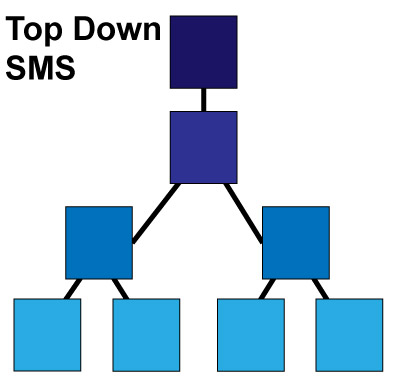Decentralization of Information

Transparency boils down to a very simple issue: information.
Specifically, control over and access to information. As I have said before, it’s a hot topic these days.
WikiLeaks, Bradley Manning, Sony, the food industry – all are examples of major front-page scandals about access to information.
That aside, I think transparency in aviation safety management systems (SMS) needs to be looked at not as the "end all be all" pinnacle of an aviation SMS, but as one critical part or method in a program that leads to healthy, mature, adaptable safety culture.
Understanding transparency simply as how to manage information makes it much easier to deal with than putting it up on a pedestal with a capital T, Transparency.
Related Aviation Safety Culture Articles
- What Is Safety Culture in the Aviation Industry?
- Examples How to Improve Safety Culture in Aviation SMS - With Resources
- Aviation Safety Cultures Improved with Integrated Safety and Quality Management Systems
Key to Optimizing Aviation SMS
Getting there is as simple as this: decentralize your information.
When information is hoarded and carefully controlled by management or a few individuals in the SMS, the fact is that aviation safety transparency just won’t happen. Aviation SMS continues to become more complex, to the point where they will soon simply be impossible to manage by one or several people. It is increasingly imperative that aviation organizations’ management lets go of despotic info-hoarding practices.
The success of aviation SMS will continue to depend less on the historical hierarchy of top-down SMS, and more on the ability of every employee to make informed decisions based on relevant information. Those decisions can’t happen when upper management is burying information like a squirrel hoarding acorns in October.
And when we are talking about information, we are talking about virtually (or ideally) almost all information, except items that require further investigation or are potentially “sensitive.” Moreover, such a step is a big one towards implementing an ICAO compliant SMS or becoming compliant with FAA's SMS requirements.
Free Flowing Communication
Of course, I’ve spoken with enough safety managers to know that these points are all very agreeable, but are often discussed with the same tone as “Oh wouldn’t that be nice to win the lotto.” And such a tone indicates an equal mindset. I think the reason for the “wouldn’t that be nice” thinking is a result of putting transparency on a pedestal.
Over-complicating it.
Let’s break down “decentralized information” a little bit further. It’s the same idea as free-flowing information. Part of this is to transition from understanding SMS as something like an org chart:

And more like a cell, the most fundamental formation in nature.

While org charts help understand the technical hierarchy of a program, imagining the structure of information flow, in the same manner, is the exact line of thinking that leads to information bottle-necking and non-transparent information practices.
Related Articles on Transparency in Aviation SMS
- How to Practice Safety Transparency and Just Culture in Aviation SMS
- Overcoming Resistance to Change Through Transparency in Aviation SMS
- Why Transparency Promotes Safety Culture in Aviation SMS
Transform Top-Down Structure to Symbiotic Relationship

Information should be disseminated back and forth between management and the general population. Free sharing sends several messages loud and clear to an organization:
- Management trusts its front-line employees
- The aviation SMS depends on employees
- Management would like to break down the management-employee barrier that plagues so many organizations
Perhaps keeping an open flow of information will fall on deaf or apathetic ears. Aviation SMS tends to practice very top-down thinking toward the attitudes, needs, and behaviors of all employees. Attitudes of management have a strange way of trickling down to all levels of the whole SMS. Wouldn’t you agree?
The result is a management-employee relationship with an open line of communication and a level of trust that is not possible in non-transparent programs. Safety cultures thrive with open communication. Healthy safety cultures report more safety reports than mistrustful safety cultures.
Top-down information flows will have a reciprocal effect with more effective hazard identification activities by engaged employees as they monitor operational activities. This hazard identification bonus results in more safety reports, which results in improved processes as these hazards are treated in the safety risk management (SRM) processes.
The result of transparency is more SMS data coming into the SMS database. Keeping employees engaged is a benefit of transparency within the SMS.
Have You Read
- Why Aviation Safety Managers Fail Without Dept Head Support in SMS
- How to Earn Top Management Support for Aviation SMS
- Advanced Aviation SMS: Top Management Support Drives SMS Profits
Eliminate Dependencies With Extreme Prejudice
Dependencies are the plague of the traditional safety program. Most SMS managers have been there. Not to be negative, but it is generally one manager who is unwilling to adapt to changes in:
- Technology
- Management
- SMS' risk management processes
- Safety culture
An all too common scenario is a highly experienced, old-school operational department head or manager who is unwilling to put any effort into adapting to new aviation SMS risk management processes, and would rather do things the “traditional way.”
The "traditional way" is to "consider" safety reports and act on them if there is time and doesn't cost too much. This "traditional way" is also very loose with
- documenting mitigating actions;
- following up in the future to validate the corrective and preventive actions; and
- sharing "lessons learned" to employees.
The "traditional way" is not to share information with employees, but to expect employees to report hazards. This one-way information flow damages the safety culture.
Or there is the manager who would rather take care of his/her department “under the table.” Yes, this is the traditional way. Very informal. No documentation. Very minimal effort and no useful data were collected for future predictive risk management activities.
Another scenario we see is the manager who is insecure about his/her position within the company and creates an information “silo” to be indispensable to his supervisors. These very tight-lipped managers are reluctant to share:
- what they know; and
- how to get the answers (train others to help themselves).
This organizational culture is about "informational power." It is a toxic safety culture and distrustful of management. These managers have learned to:
- Keep the most valuable information to yourself, except when it will benefit you directly.
These are common real-world scenarios that create obstructive people-dependencies. Which ones have you dealt with?
Such practices, beliefs, and behaviors will completely roadblock any efforts toward transparency. Although it may lead to an uncomfortably candid conversation, eliminating such dependencies needs to happen to develop a transparent SMS and subsequently improve the safety culture.
Why Is Transparency So Difficult to Practice in SMS?

Traditional safety programs are still in our common memory. Human attitudes and behaviors are slow to change. It has only been since November 2006 that SMS was mandated by ICAO for all member states. Since then, aviation service providers have been working hard (well, some of them anyway) toward implementing their SMS and improving their safety cultures.
Just culture and healthy safety cultures are common terms used today for the new way of doing business in the aviation industry. Considerable time will be required for most companies to shift from a culture of "not sharing safety information" to a culture of "sharing all relevant safety information." The transition to a transparent safety culture requires a
- change in attitudes (both managerial and employees);
- convenient way to disseminate safety information;
- modern data management strategies to easily draft and distribute relevant safety information; and
- secure data management strategies that allow authorized employees to discover desensitized safety information on their own.
The "transparency argument" has been made and there are few objections to the benefits of sharing more safety information among the SMS stakeholders. An obvious benefit of transparency is increased employee morale and productivity. From the organization's perspective, the most valuable benefit will stem from increased employee participation in the SMS by:
- safety reporting;
- heightened awareness of proactive hazard identification;
- completing assigned safety tasks on time; and
- improved business processes resulting from managing reported incidents and close calls.
Since traditional safety programs did not have the data management capabilities of today's modern SMS, it is easy to understand why more safety data was not disseminated to employees. In short, there was not a lot of documented safety data prepared to distribute and the burden to get approval for sharing safety information from upper management levels was often insurmountable.
In traditional safety programs, safety managers did not have an efficient method of disseminating safety information. With the advent of SMS, every company with an SMS will have developed and established means for safety communications in Phase 1 of the SMS implementation.
Related Aviation Safety Culture Articles
- 3 Reasons Why Aviation Safety Culture Leads Directly to Safety Performance
- How Top Management Kills Aviation Safety Culture - With Examples
- How to Re-Engineer Your Aviation Safety Culture?
Strategies to Share Safety Information in Transparent Safety Culture
The next step is to have data to share. The low-hanging fruit will be to create a simple Lessons Learned Library. Some aviation SMS databases come with a Lessons Learned Library. Lessons Learned Libraries are repositories of case studies prepared from investigations related to reported safety issues.
The most common workflow to create a lesson learned is:
- Employee submits safety issue;
- Management conduct investigation and apply mitigation measures;
- Final investigation report is created for management and/or regulatory authorities;
- Lessons Learned created by safety team based on investigation and subsequent analysis;
- Lesson Learned is distributed to relevant employees; and
- Lesson Learned is stored in the SMS database for later use in training or other investigations.
A Lesson Learned Library is certainly among the lowest-hanging fruit to jump-start your "SMS data transparency initiative." They are easy to manage and can be used in so very many ways to promote SMS and to promote safety.
Another strategy for enhanced SMS information transparency is to provide employees access to desensitized safety reports. In SMS Pro, we call this the "General Issue Viewer." Any employee can search the database for desensitized safety reports. The data returned will have been scrubbed by the safety team or the safety committee.
Have You Read
- How Mistakes Improve Aviation SMS Processes - Lessons Learned Library
- Privacy, Transparency, and Confidentiality in Aviation Safety Management
- Transparency and Aviation Safety Data Security
Final Thought: Transparency Is a Self-Managing System
As I have said, SMS will only continue to become more complex to keep up with:
- Rapidly changing technology
- Evolving hazards
- More data points to monitor
- The weight of historical compliance
In smaller and older aviation SMS, a top-down management approach to managing safety was (and is in small companies) more viable. But that’s becoming increasingly impossible. Complex systems need to function more like living, self-managing beings, and transparency is one important step in that direction.
Tools to Practice Transparency in Aviation SMS
Developing an open, sharing culture is not sustainable when the safety team has to work too hard to share information. If it is not easy, then it will not happen on a repeatable basis. We saw this in the traditional safety programs.
Managing SMS data using spreadsheets is not a sustainable process, except in the smallest SMS implementations. For companies with more than 40 employees or smaller companies with high employee turnover, an SMS database is recommended.
An SMS database provides many professional safety tools to facilitate data sharing among employees. For example, SMS Pro has many secure, safety promotion tools to create a culture of transparency, including:
- Lessons Learned Library;
- Meeting Manager;
- Safety Newsletters;
- Message Board;
- Hazard Register;
- General Issue Viewer; and
- Training Article Library.
These following short demo videos offer a glimpse into SMS Pro. Please watch them to get ideas on how you can benefit from similar tools. If you like our ideas, you can either acquire an SMS Pro subscription or develop these tools on your own. We don't mind sharing. In fact, we cannot stop our competitors from taking our ideas, so we quit trying. SMS Pro is also run by a very transparent company. You will see evidence of our transparent culture by reviewing our website. No other SMS database provider is so open to sharing information.
Live SMS Pro Demo
Do you like what you see? Would you like to see a live demo? Sign up below.
One way to get employees involved is to have a good non-punitive reporting policy. Here is a great resource that will save you time and energy either creating a new policy or reviewing an existing policy.
Last updated in September 2025.









